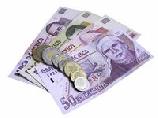
 |
|
| Financial Terms | |
| Statement-of-cash-flows method |
|
Information about financial, finance, business, accounting, payroll, inventory, investment, money, inventory control, stock trading, financial advisor, tax advisor, credit.
Main Page: financial, payroll, finance, business, financial advisor, inventory, accounting, inventory control, |
Definition of Statement-of-cash-flows method
Statement-of-cash-flows methodA method of cash budgeting that is organized along the lines of the statement of cash flows.
Related Terms:NPV (net present value of cash flows)Same as PV, but usually includes a subtraction for an initial cash outlay. PV (present value of cash flows)the value in today’s dollars of cash flows that occur in different time periods. Capitalization methodA method of constructing a replicating portfolio in which the manager purchases a CashThe value of assets that can be converted into cash immediately, as reported by a company. Usually Cash budgetA forecasted summary of a firm's expected cash inflows and cash outflows as well as its Cash and carryPurchase of a security and simultaneous sale of a future, with the balance being financed Cash and equivalentsThe value of assets that can be converted into cash immediately, as reported by a  Cash commodityThe actual physical commodity, as distinguished from a futures contract. Cash conversion cycleThe length of time between a firm's purchase of inventory and the receipt of cash Cash cowA company that pays out all earnings per share to stockholders as dividends. Or, a company or Cash cycleIn general, the time between cash disbursement and cash collection. In net working capital Cash deficiency agreementAn agreement to invest cash in a project to the extent required to cover any cash Cash deliveryThe provision of some futures contracts that requires not delivery of underlying assets but Cash discountAn incentive offered to purchasers of a firm's product for payment within a specified time Cash dividendA dividend paid in cash to a company's shareholders. The amount is normally based on Cash equivalentA short-term security that is sufficiently liquid that it may be considered the financial  Cash flowIn investments, it represents earnings before depreciation , amortization and non-cash charges. Cash flow after interest and taxesNet income plus depreciation. Cash flow coverage ratioThe number of times that financial obligations (for interest, principal payments, Cash flow from operationsA firm's net cash inflow resulting directly from its regular operations Cash flow matchingAlso called dedicating a portfolio, this is an alternative to multiperiod immunization in Cash flow per common sharecash flow from operations minus preferred stock dividends, divided by the Cash flow time-lineLine depicting the operating activities and cash flows for a firm over a particular period. Cash-flow break-even pointThe point below which the firm will need either to obtain additional financing Cash management billVery short maturity bills that the Treasury occasionally sells because its cash Cash marketsAlso called spot markets, these are markets that involve the immediate delivery of a security Cash offerA public equity issue that is sold to all interested investors. Cash ratioThe proportion of a firm's assets held as cash. Cash settlement contractsFutures contracts, such as stock index futures, that settle for cash, not involving Cash transactionA transaction where exchange is immediate, as contrasted to a forward contract, which Cash-equivalent itemsTemporary investments of currently excess cash in short-term, high-quality Cash-surrender valueAn amount the insurance company will pay if the policyholder ends a whole life CashoutRefers to a situation where a firm runs out of cash and cannot readily sell marketable securities. Convention statementAn annual statement filed by a life insurance company in each state where it does Current rate methodUnder this currency translation method, all foreign currency balance-sheet and income Direct estimate methodA method of cash budgeting based on detailed estimates of cash receipts and cash Discounted cash flow (DCF)Future cash flows multiplied by discount factors to obtain present values. Discretionary cash flowcash flow that is available after the funding of all positive NPV capital investment Equivalent annual cash flowAnnuity with the same net present value as the company's proposed investment. Expected future cash flowsProjected future cash flows associated with an asset of decision. Flow-through methodThe practice of reporting to shareholders using straight-line depreciation and Free cash flowscash not required for operations or for reinvestment. Often defined as earnings before General cash offerA public offering made to investors at large. Income statement (statement of operations)A statement showing the revenues, expenses, and income (the Incremental cash flowsDifference between the firm's cash flows with and without a project. Ledger cashA firm's cash balance as reported in its financial statements. Also called book cash. Log-linear least-squares methodA statistical technique for fitting a curve to a set of data points. One of the Monetary / non-monetary methodUnder this translation method, monetary items (e.g. cash, accounts Net cash balanceBeginning cash balance plus cash receipts minus cash disbursements. Nominal cash flowA cash flow expressed in nominal terms if the actual dollars to be received or paid out are given. Noncash chargeA cost, such as depreciation, depletion, and amortization, that does not involve any cash outflow. Normalizing methodThe practice of making a charge in the income account equivalent to the tax savings Notes to the financial statementsA detailed set of notes immediately following the financial statements in Official statementA statement published by an issuer of a new municipal security describing itself and the issue Operating cash flowEarnings before depreciation minus taxes. It measures the cash generated from Pro forma financial statementsFinancial statements as adjusted to reflect a projected or planned transaction. Pro forma statementA financial statement showing the forecast or projected operating results and balance Purchase methodAccounting for an acquisition using market value for the consolidation of the two entities' Real cash flowA cash flow is expressed in real terms if the current, or date 0, purchasing power of the cash Registration statementA legal document that is filed with the SEC to register securities for public offering. Residual methodA method of allocating the purchase price for the acquisition of another firm among the Scheduled cash flowsThe mortgage principal and interest payments due to be paid under the terms of the Simple compound growth methodA method of calculating the growth rate by relating the terminal value to Statement billingBilling method in which the sales for a period such as a month (for which a customer also Statement of cash flowsA financial statement showing a firm's cash receipts and cash payments during a Statement of Financial Accounting Standards No. 8This is a currency translation standard previously in Statement of Financial Accounting Standards No. 52This is the currency translation standard currently Symmetric cash matchingAn extension of cash flow matching that allows for the short-term borrowing of Target cash balanceOptimal amount of cash for a firm to hold, considering the trade-off between the Temporal methodUnder this currency translation method, the choice of exchange rate depends on the Wanted for cashA statement displayed on market tickers indicating that a bidder will pay cash for same day CASH AND CASH EQUIVALENTSThe balance in a company’s checking account(s) plus short-term or temporary investments (sometimes called “marketable securities”), which are highly liquid. CASH-FLOW STATEMENTA statement that shows where a company’s cash came from and where it went for a period of time, such as a year. CASH FLOWS FROM FINANCING ACTIVITIESA section on the cash-flow statement that shows how much cash a company raised by selling stocks or bonds this year and how much was paid out for cash dividends and other finance-related obligations. CASH FLOWS FROM INVESTING ACTIVITIESA section on the cashflow statement that shows how much cash came in and went out because of various investing activities like purchasing machinery. CASH FLOWS FROM OPERATIONSA section on the cash-flow Stockholders’ equity statement that shows how much cash came into a company and how much went out during the normal course of business. INCOME STATEMENTAn accounting statement that summarizes information about a company in the following format: Cash accountingA method of accounting in which profit is calculated as the difference between income Cash costThe amount of cash expended. Cash Flow statementA financial report that shows the movement in cash for a business during an accounting period. Cash value added (CVA)A method of investment appraisal that calculates the ratio of the net present value of an Discounted cash flow (DCF)A method of investment appraisal that discounts future cash flows to present value using a discount rate, which is the risk-adjusted cost of capital. Financial reports or statementsThe Profit and Loss account, Balance Sheet and cash Flow statement of a business. Allowance methodA method of adjusting accounts receivable to the amount that is expected to be collected based on company experience. CashAmounts held in currency and coin (commonly referred to as petty cash) and amounts on deposit in financial institutions. Cash receipts journalA journal used to record the transactions that result in a debit to cash. Direct methodA method of preparing the operating section of the statement of cash flows that uses the company’s actual cash inflows and cash outflows. Direct write-off methodA method of adjusting accounts receivable to the amount that is expected to be collected by eliminating the account balances of specific nonpaying customers. Income StatementOne of the basic financial statements; it lists the revenue and expense accounts of the company. Indirect methodA method of preparing the operating section of the statement of cash flows that does not use the company’s actual cash inflows and cash outflows, but instead arrives at the net cash flow by taking net income and adjusting it for noncash expenses and the changes from last year in the current assets and current liabilities. Petty cashThe amount of currency and coin that a company keeps on hand to pay for small purchases and expenses. Statement of Cash FlowsOne of the basic financial statements; it lists the cash inflows and cash outflows of the company, grouped into the categories of operating activities, financing activities, and investing activities. The statement of cash flows is prepared for a specified period of time. Statement Retained EarningsOne of the basic financial statements; it takes the beginning balance of retained earnings and adds net income, then subtracts dividends. The statement of Retained Earnings is prepared for a specified period of time. cash burn rateA relatively recent term that refers to how fast a business cash flowAn obvious but at the same time elusive term that refers to cash cash flow from operating activities, or cash flow from profitThis equals the cash inflow from sales during the period minus the cash statement of cash flowsOne of the three primary financial statements discounted cash flow (DCF)Refers to a capital investment analysis technique statement of financial conditionSee balance sheet. Related to : financial, finance, business, accounting, payroll, inventory, investment, money, inventory control, stock trading, financial advisor, tax advisor, credit. |